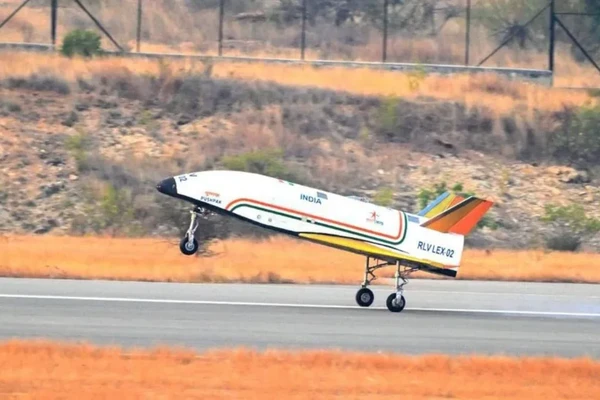Recently, the Indian Space Research Organisation (ISRO) successfully conducted the Pushpak Reusable Landing Vehicle (RLV) LEX 02 landing experiment at the Aeronautical Test Range in Chitradurga.
- RLV LEX-02 is the second experiment in the series conducted by ISRO under the Reusable Launch Vehicle Technology Demonstration (RLV-TD) Programme, following the completion of the RLV-LEX-01 mission in 2023.
About Reusable Landing Vehicle (RLV) LEX 02 experiment:
- RLV-LEX-02 demonstrates the autonomous landing capability of the Reusable Launch Vehicle (RLV) from off-nominal initial conditions at release from helicopter.
- The RLV successfully executed complex maneuvers, adjusted for both sideways and forward distances, and autonomously landed on the runway.
- This mission re-validated indigenous technologies in navigation, control systems, landing gear, and deceleration systems crucial for high-speed autonomous landing of space-returning vehicles.
- Flight hardware and systems from RLV-LEX-01 were reused in RLV-LEX-02 after necessary certifications, demonstrating ISRO’s reuse capability and cost-effectiveness.
- The winged vehicle, called Pushpak was lifted by an Indian Air Force Chinook Helicopter and was released from 4.5 km altitude.
About RLV-TD Programme:
- RLV-TD is one of the most challenging endeavours of the ISRO towards developing essential technologies for a fully reusable launch vehicle to enable low-cost access to space.
- The configuration of RLV-TD is similar to that of an aircraft and combines the complexity of both launch vehicles and aircraft.
- The RLV-TD is a winged vehicle that serves as a flying test bed to evaluate technologies such as hypersonic flight, powered cruise flight, and autonomous landing.
- The RLV-TD has four major steps before the development of the final Reusable Launch Vehicle (RLV):
- Hypersonic Flight Experiment (HEX)
- Landing Experiment (LEX)
- Return Flight Experiment (REX)
- Scramjet Propulsion Experiment (SPEX)
- This vehicle will be scaled up to become the first stage of India’s reusable two stage orbital launch vehicle.
What is a reusable launch vehicle?
- A reusable launch vehicle has parts that can be recovered and reflown, while carrying payloads from the surface to outer space.
- RLV is essentially a space plane with a low lift-to-drag (L/D) ratio that can transport payloads to low Earth orbits and return to Earth.
- NASA and private space agencies like SpaceX have utilized reusable space vehicles (RLVs) for human spaceflight missions.
- The Space Shuttles and SpaceX’s Falcon 9 and Falcon Heavy rockets are prime examples of such technology.
- RLVs are valued for their cost-effectiveness, reliability, and ability to provide on-demand access to space.
- Challenges include selecting materials like special alloys, composites, and insulation, as well as crafting their parts, which demand highly skilled manpower due to the complexity involved.
Ref:Source
| UPSC IAS Preparation Resources | |
| Current Affairs Analysis | Topperspedia |
| GS Shots | Simply Explained |
| Daily Flash Cards | Daily Quiz |



